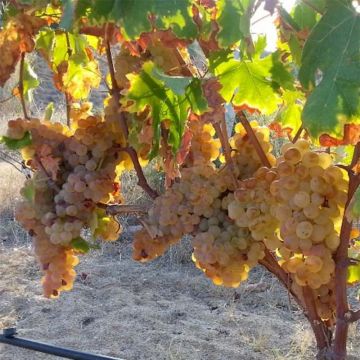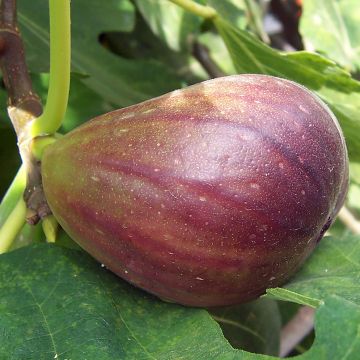

Vitis vinifera Centennial - Seedless Grape vine
Vitis vinifera Centennial - Seedless Grape vine
Vitis vinifera Centennial seedless
Common Grape Vine, European Grape, Wine Grape
Special offer!
Receive a €20 voucher for any order over €90 (excluding delivery costs, credit notes, and plastic-free options)!
1- Add your favorite plants to your cart.
2- Once you have reached €90, confirm your order (you can even choose the delivery date!).
3- As soon as your order is shipped, you will receive an email containing your voucher code, valid for 3 months (90 days).
Your voucher is unique and can only be used once, for any order with a minimum value of €20, excluding delivery costs.
Can be combined with other current offers, non-divisible and non-refundable.
Why not try an alternative variety in stock?
View all →This plant carries a 6 months recovery warranty
More information
We guarantee the quality of our plants for a full growing cycle, and will replace at our expense any plant that fails to recover under normal climatic and planting conditions.
Description
Vitis vinifera Centennial Seedless is a vigorous variety of vine, capable of reaching up to 5m (16ft) in height when trained on a trellis or arbour. This variety produces a sweet, muscat-flavoured, golden yellow table grape, ready to be harvested as early as August in warm southern regions. The large clusters of medium to large berries are resistant to rot but susceptible to powdery mildew. In addition to being delicious, these grapes have the advantage of being seedless. This vine thrives in most neutral to limestone, well-drained soils in sunny locations. It is also hardy.
The wine grapevine (Vitis vinifera) grew wild over 5000 years ago in North and Central America, Europe, and Central and Eastern Asia. The subspecies sylvestris still exists as a climbing liana, growing on the edges of forests and capable of reaching great heights in trees. The current varieties, called grape varieties in the case of the vine, are classified under the vinifera subspecies (although there are other cultivated species, but they are very minor). Economically, wine grapes dominate over table grapes, with over 200 authorised grape varieties in France, the result of centuries of selection work.
'Centennial Seedless' is an American variety obtained in 1966 by Professor Harold P. Olmo, a viticulturist and teacher at the University of Davis in California. This specialist in the genus, with a doctorate in plant genetics, worked extensively on American viticulture during his long life (he died at the age of 97, perhaps a good illustration of the benefits of grapes on the body?). A vigorous climbing bush, the Centennial Seedless vine requires long pruning, ideally of the Guyot method, and training on wires. It can also be grown on a trellis or arbour that it can cover. It is capable of reaching 5m (16ft) in height and 4m (13ft) in width if left unpruned.
Its deeply cut foliage, with 5 to 7 deeply toothed lobes, is very characteristic and quite decorative, especially since the young leaves are reddish, while in autumn they turn yellow-orange. Flowering occurs in June depending on the year and region, offering very small greenish flowers gathered in fairly large conical and cylindrical clusters. Like most grapes, it is a self-fertile variety.
The inflorescences develop into large clusters of medium to large berries, which turn golden yellow at maturity from early to mid-August in sunny southern regions (a few days after Chasselas). With thin skin and firm flesh, these berries are sweet, slightly acidic, and have a slightly muscat flavour. They have a distinctly elongated shape (about 16 x 20mm (1in)), with each grape weighing from 3 to 5 grams and clusters weighing from 400 to 500 grams. These succulent berries have the advantage, as indicated by the variety's name, of being seedless. It is useful to do green pruning to remove certain leaves so that the grapes are well exposed to the sun and can acquire their beautiful golden colour, a sign of their taste quality. However, be sure to provide them with some shade in warm regions to prevent the fruits from browning in the sun. This variety is somewhat susceptible to powdery mildew, less so to downy mildew, and not very susceptible to grey rot.
Centennial Seedless grapes can be consumed fresh or made into juice, for example in a vitamin-packed fruit cocktail at breakfast. In general, grapes are rich in B vitamins, a source of fibre and manganese, and well-supplied with antioxidants. They are also believed to play a role in preventing cardiovascular diseases, and most importantly, they are a healthy, natural, and delicious dessert. Plant Centennial Seedless alongside other vines, especially black grape varieties like the famous Muscat de Hambourg, to multiply the flavours and the pleasure.
Report an error about the product description
Vitis vinifera Centennial - Seedless Grape vine in pictures


Plant habit
Fruit
Flowering
Foliage
Botanical data
Vitis
vinifera
Centennial seedless
Vitaceae
Common Grape Vine, European Grape, Wine Grape
Cultivar or hybrid
Other Grapevines
View all →Planting and care
Since the ravages of phylloxera at the end of the 19th century, the vine is obligatorily grafted onto different resistant rootstocks adapted to different types of soil. These rootstocks come from American varieties naturally armed against this formidable parasite, which itself originates from America.
Plant the Centennial Seedless vine in autumn, in deep, well-drained soil, even stony, clayey, and chalky, knowing that the vine is not demanding in terms of the chemical nature of the soil. It can adapt to moderately acidic soil (to pH 6, as below this there are assimilation blockages of certain trace elements), neutral, and alkaline up to pH 8.5 (knowing that in this case, it is actually the excess of active lime that is harmful).
Plant it in a well-exposed, sunny location, sheltered from strong, cold, and dry winds. This variety can withstand winter frosts, it is hardy down to -20°C. Incorporate 3 or 4 handfuls of fruit tree fertiliser and 2kg of well rotted manure for each vine into the planting soil. Be careful, the roots should not come into contact with the manure. This variety responds well to long pruning in the Guyot method*
The vine does not require regular fertiliser application for good yields, quite the opposite. In overly rich soil, vegetation (leaves) will develop at the expense of fruiting. Enrich the soil with potash slag, crushed horn, or iron chelate, only every 2-3 years.
*The Guyot pruning method is a mixed pruning method on a short framework. The stump consists of a trunk extended by an arm (upper woody climbing stem) and a spur (lower woody climbing stem) with two buds. The length of the arm depends on the vigour of the stump. After training the trunk, the formation pruning of the vine consists of pruning the canes to give structure to the stump. Annual pruning consists of removing fruiting wood and pruning the spurs.
Planting period
Intended location
Care
This item has not been reviewed yet - be the first to leave a review about it.
Similar products
Haven't found what you were looking for?
Hardiness is the lowest winter temperature a plant can endure without suffering serious damage or even dying. However, hardiness is affected by location (a sheltered area, such as a patio), protection (winter cover) and soil type (hardiness is improved by well-drained soil).

Photo Sharing Terms & Conditions
In order to encourage gardeners to interact and share their experiences, Promesse de fleurs offers various media enabling content to be uploaded onto its Site - in particular via the ‘Photo sharing’ module.
The User agrees to refrain from:
- Posting any content that is illegal, prejudicial, insulting, racist, inciteful to hatred, revisionist, contrary to public decency, that infringes on privacy or on the privacy rights of third parties, in particular the publicity rights of persons and goods, intellectual property rights, or the right to privacy.
- Submitting content on behalf of a third party;
- Impersonate the identity of a third party and/or publish any personal information about a third party;
In general, the User undertakes to refrain from any unethical behaviour.
All Content (in particular text, comments, files, images, photos, videos, creative works, etc.), which may be subject to property or intellectual property rights, image or other private rights, shall remain the property of the User, subject to the limited rights granted by the terms of the licence granted by Promesse de fleurs as stated below. Users are at liberty to publish or not to publish such Content on the Site, notably via the ‘Photo Sharing’ facility, and accept that this Content shall be made public and freely accessible, notably on the Internet.
Users further acknowledge, undertake to have ,and guarantee that they hold all necessary rights and permissions to publish such material on the Site, in particular with regard to the legislation in force pertaining to any privacy, property, intellectual property, image, or contractual rights, or rights of any other nature. By publishing such Content on the Site, Users acknowledge accepting full liability as publishers of the Content within the meaning of the law, and grant Promesse de fleurs, free of charge, an inclusive, worldwide licence for the said Content for the entire duration of its publication, including all reproduction, representation, up/downloading, displaying, performing, transmission, and storage rights.
Users also grant permission for their name to be linked to the Content and accept that this link may not always be made available.
By engaging in posting material, Users consent to their Content becoming automatically accessible on the Internet, in particular on other sites and/or blogs and/or web pages of the Promesse de fleurs site, including in particular social pages and the Promesse de fleurs catalogue.
Users may secure the removal of entrusted content free of charge by issuing a simple request via our contact form.
The flowering period indicated on our website applies to countries and regions located in USDA zone 8 (France, the United Kingdom, Ireland, the Netherlands, etc.)
It will vary according to where you live:
- In zones 9 to 10 (Italy, Spain, Greece, etc.), flowering will occur about 2 to 4 weeks earlier.
- In zones 6 to 7 (Germany, Poland, Slovenia, and lower mountainous regions), flowering will be delayed by 2 to 3 weeks.
- In zone 5 (Central Europe, Scandinavia), blooming will be delayed by 3 to 5 weeks.
In temperate climates, pruning of spring-flowering shrubs (forsythia, spireas, etc.) should be done just after flowering.
Pruning of summer-flowering shrubs (Indian Lilac, Perovskia, etc.) can be done in winter or spring.
In cold regions as well as with frost-sensitive plants, avoid pruning too early when severe frosts may still occur.
The planting period indicated on our website applies to countries and regions located in USDA zone 8 (France, United Kingdom, Ireland, Netherlands).
It will vary according to where you live:
- In Mediterranean zones (Marseille, Madrid, Milan, etc.), autumn and winter are the best planting periods.
- In continental zones (Strasbourg, Munich, Vienna, etc.), delay planting by 2 to 3 weeks in spring and bring it forward by 2 to 4 weeks in autumn.
- In mountainous regions (the Alps, Pyrenees, Carpathians, etc.), it is best to plant in late spring (May-June) or late summer (August-September).
The harvesting period indicated on our website applies to countries and regions in USDA zone 8 (France, England, Ireland, the Netherlands).
In colder areas (Scandinavia, Poland, Austria...) fruit and vegetable harvests are likely to be delayed by 3-4 weeks.
In warmer areas (Italy, Spain, Greece, etc.), harvesting will probably take place earlier, depending on weather conditions.
The sowing periods indicated on our website apply to countries and regions within USDA Zone 8 (France, UK, Ireland, Netherlands).
In colder areas (Scandinavia, Poland, Austria...), delay any outdoor sowing by 3-4 weeks, or sow under glass.
In warmer climes (Italy, Spain, Greece, etc.), bring outdoor sowing forward by a few weeks.


























































